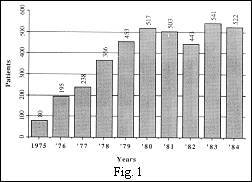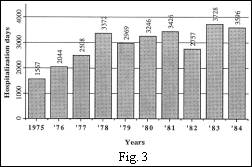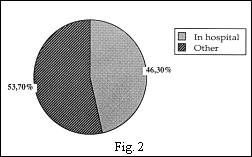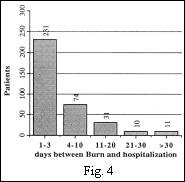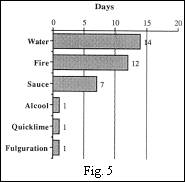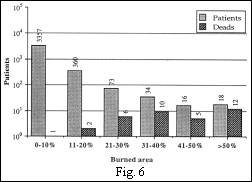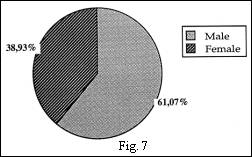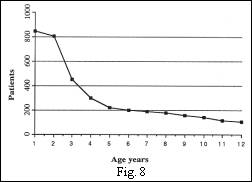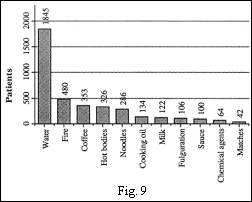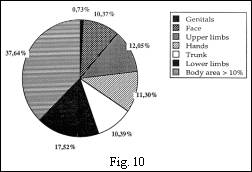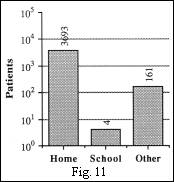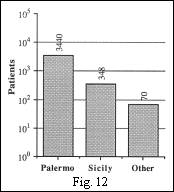Annals
of the M.B.C. - vol. 1° - n° 1 - September 1987
10 YEARS OF BURNS IN
CHILDREN:
A STATISTICAL STUDY WITH A VIEW TO A PREVENTION CAMPAIGN
Amico M., Caputo G., Geraci V., Ferrara
M.M.
Divisione di chirurgia plastica - U.S.L. 58 - Palermo
SUMMARY. The
Authors have carried out i statistical analysis of bums in childreen aged 0-12 years
admitted to our Bums Centre in the decade 1975-84.
The data were processed on an Olivetti M20 Personal Computer.
Tha analysis shows a total number of 3858 children treated for burns, 1788 after admission
to the Centre and 2070 in the Day-hospital.
There were 36 deaths.
The commonest burning agent was water.
The age-range most affected was pre-school.
The florne was the most frequent scene of bum accidents.
Other data taken into consideration were: sex, B.S.A., place of origin, site of bum, self
discharge, relationship between death from bums and aetiological agent, patients arriving
some tim( after the bum lesion and the total number of days of hospitalization.
This collection of data has enabled the Authors to set up a programme for a prevention
campaign.
They express the hope that in a subsequent ijivestigation the present data will be
considerably reduced.
The observation of
numerous cases of children in the 0-12 year age-range who daily come to our attention with
more or less diffuse burn, led us to carry out a statistical analysis of all these
patients who came to our Burn Centre in the decade 1~75/84.
Our intention in this analysis
was to collect as many data as possible in order tc set up a work programme aimed at a
campaign of prevention.
An M20 Olivetti personal computer
was used to process the data. The total number of cases in this decade was 3858, which was
37.30N, of all burn patients in that period (Fig. 1).
The patients were divided into
two categories, minor burn patients and major burn patients, the first referring to cases
in which small areas - up to 10% - of BSA were affected, the second to those with greater
areas - over 10% - affected and/or involvement of "critical areas", i.e. face,
hands, articulation folds etc.
The minor burn patients were
treated as outpatients and the major burn patients were hospitalized, and totalled
respectively 2070 (5 3.7%) and 1788 (46.3%) (Fig. 2).
The overall number of days of
hospitalization was 29213 (Fig. 3). 11.4% of the hospitalized patients were subjected to
surgery.
There were 379 cases of
self-discharge. In most of these cases, the children returned to our observation soon
afterwards, usually with infective complications.
Some patients came to our
attention some days after the burn lesion. We registerec 357 such cases, representing a
rather high percentage of 9.5%, distributed as follows: 231 cases after 1-3 days, 74 after
4-10 days, 31 after 11-20 days, 10 after 21-30 days and I I after more than 30 days (Fig.
4).
These young patients has been treated either in another hospital, or at home, or, even
worse, empirically by faith-healers. They therefore arrived in our Centre riearly always
with co-riplications and often seriously ill.
The number of deaths was 36
(0.93%). Of these the bum agent was boiling wai.er in 14 cases, fire in 12, boiling tomato
sauce in 7, surgical spirit in 1, electrocution in 1 and quicklime
in 1 (Fig. 5).
Comparing the number of patients,
BSA involved, and deaths with the skin area burned we found that there were:
3357 cases of burns of 0-.10% of BSA,
with I death;
360 of 11-20% of BSA, wi-.h 2
deaths;
73 of 21-30% of BSA, with 6
deaths;
34 of 31-40% of BSA, with 10
deaths;
16 of 41-50% of BSA, witli 5
deaths;
18 of over 50% of BSA, w th 12
deaths (Fig. 6).
The sex breakdown was 2356 boys (61.1%) to 1502 girls (38.9%) (Fig. 7).
The age with the highest accident rate was preschool, particularly at one and Iwo years,
with a maximum of 849 cases at I year and 803 at 2 years, gradually reducing with age down
to a minimum of 106 cases at 12 years (Fig. 8).
The causes of the burn lesions were:
- red-hot objects (irons, oven glass, heaters etc.);
- flame (surgical spirit, petrol, gas cylinder explosion etc.);
- boiling
liquids (water, pap, milk, coffee, tea, oil, sauce);
- chemical
agents (wastepipe cleaner, muriatic acid, caustic soda etc.);
- matches;
- electric
shock.
The most frequent burning age.,it was water (1845 cases) followed by flame (480 cases).
A characteristic burning agent in our geographical area is homemade tomato sauce,
responsible for 100 cases and, as we have seen, 7 deaths (Fig. 9).
As for the site of the burns we have shown that 1452 patients were affected in more than
10% of total BSA. The part of the body most often involved was the upper limb including
the hand with 901 cases, followed by the lower limbs (676 cases) and the face (400 cases)
(Fig. 10).
Contrary to the popular opinion that children are safe from accident at home, our
data show that the home is the place where the highest number of accidents occurred - 3693
cases, with 4 at school and 161 outside the home (Fig. 11).
We distinguished the place of origin into three geographical areas: Palermo and province
3440 cases; other Sicilian provinces 348 cases; and places outside the island 70 cases
(Fig. 12).
The circumstances determining burns in children will today be the subject of a film
entitled "The Prevention of Burns in Childrer", which this survey has in part
enabled us to produce.
We sincerely hope that our next survey will show considerably reduced data compared to our
present ones.
RÉSUMÉ. Les auteurs
ont analysé statistiquement les brûlures produites'sur des enfants de 0 à 12 ans,
hospitalisés au Centre de Brûlures de Palerme entre 1975 et 1984.
Pour analyser ces données, on a utilisé un Personal Computer Olivetti M20. Le total des
petits malades traités pour brûlures a été de 3858, dont 1788 hospitalisés et 2070
soignés dans différents cabinets médicaux. 36 sont décédés.
L'agent qui provoque les brûlures est le p1us souvent l'eau.
Les enfants atteints sont pour la plupari ceux qui ne vont pas encore à l'école. C'est
donc à la maison que ces accidents arrivent le plus fréquemment.
D'autres données ont également été priscs en considération: le sexe, la partie du
corps concerné, le lieu de provenance, les sorties d'hôpital volontaire, le rapport
entre la mort par brûlure et l'agent étiologique, les sujets hospitalisés avec un
certain retard et le nombre de jours d'hospitalisation.
Toutes ces données ont permis aux auteurs de faire un programme pour une campagne de
prévention.
Ils souhaitent qu'une prochaine enquête révélera que les données actuelles auront
considérablement diminué due à la campagne de prévention entreprise depuis lors.
|
